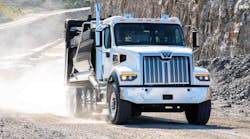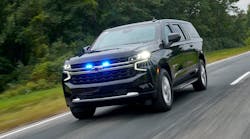The world’s leading manufacturers of heavy-duty commercial trucks and engines have endorsed a harmonized global approach as an effective pathway to further improving energy efficiency and reducing greenhouse gas emissions from commercial vehicles.
Meeting in Chicago, the chief executives of commercial vehicle and engine manufacturers in Europe, Japan and the United States discussed fuel efficiency and greenhouse gas emission reductions, diesel fuel specifications and topics related to heavy-duty engine and vehicle regulation and certification.
The meeting was chaired by Tom Linebarger, Chairman and Chief Executive Officer of Cummins Inc. This was the eleventh meeting of the chief executives to discuss global issues and address challenges facing commercial vehicle and engine manufacturers.
“Over the last decade engine and vehicle manufacturers have successfully reduced emissions to near zero levels,” Linebarger said. “Having developed technologies to reduce criteria emissions, commercial engine and vehicle manufacturers are now focused on improving energy efficiency and reducing greenhouse gas emissions to better serve our customers and improve the global environment. We can best accomplish that when government and industry work together to achieve a common goal, using an agreed-upon set of compatible standards and global measurement procedures.
“The outcome of our meetings in Chicago was to affirm our commitment to work with governments around the world to establish a set of aligned global standards and measurement procedures related to fuel quality, energy efficiency improvements and greenhouse gas reductions.”
The manufacturers agreed to continue their efforts to develop improved and harmonized fuels, testing and certification practices and procedures related to criteria emissions reductions, fuel efficiency improvements and greenhouse gas reductions.
“As manufacturers of products used across the globe, our ability to introduce new and innovative technologies is hindered by conflicting and inefficient regulatory requirements adopted in different countries” Linebarger saod. “Assuring that European, Japanese, and North American regulators adopt coordinated and compatible specifications, procedures and approval requirements related to improved fuel quality, exhaust emissions and energy efficiency standards will significantly improve our ability to effectively meet the needs of our commercial vehicle customers as well as global environmental goals.”
Continuing the progress made at previous meetings, the chief executives discussed topics related to:
· Adoption of a world-wide heavy-duty emissions certification procedure.
· Harmonization of fuel specifications and regulations.
· Progress in the harmonization of fuel efficiency assessment methods including vehicle simulation modeling.
· Fuel efficiency improvements and greenhouse gas reductions.
· Requirements for certification of heavy-duty hybrid vehicles.
In addition to the participation of the chief executives, the meeting brought together representatives of the European Automobile Manufacturers Association (ACEA), the Japan Automobile Manufacturers Association (JAMA), and the Truck and Engine Manufacturers Association (EMA).








